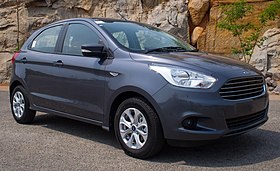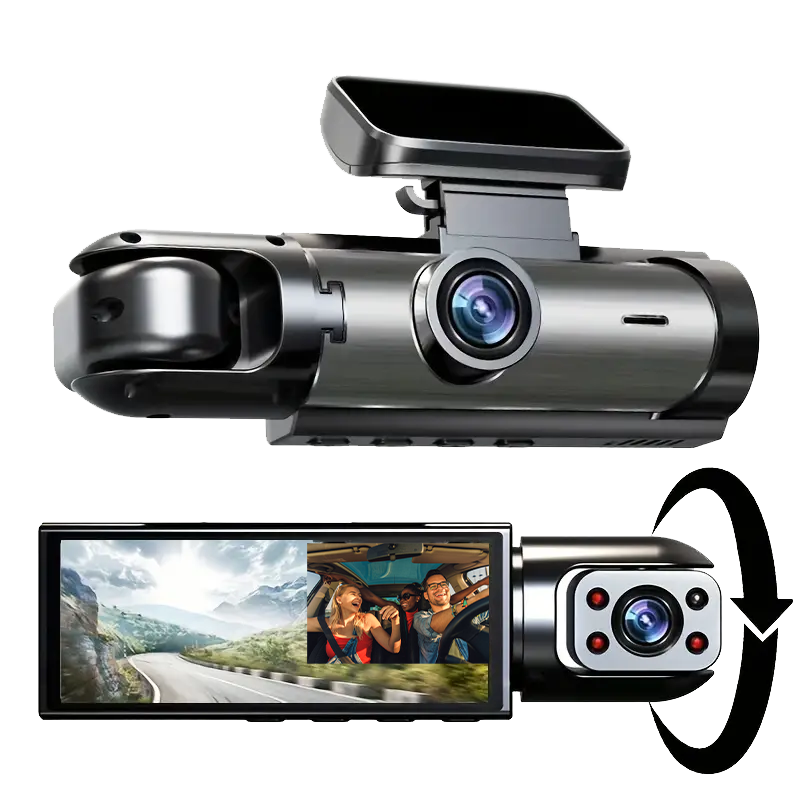
Ford Ka+ 2014–present

| Third generation | |
|---|---|
 |
|
| Overview | |
| Also called | Ford Figo (India, Mexico) Ford Ka+ (Europe & sedan in Brazil) |
| Production | 2014–present |
| Assembly | Camaçari, Brazil Sanand, Gujarat, India |
| Body and chassis | |
| Class | Subcompact car |
| Body style | 5-door hatchback 4-door sedan |
| Platform | Ford global B-car platform |
| Related | Ford Fiesta |
| Powertrain | |
| Engine | 1.0 L I3 (petrol) 1.2 L I4 (petrol) 1.5 L I4 (petrol) 1.5 L I4 (diesel) |
| Transmission | 5-speed manual 6-speed automatic (PowerShift) |
| Dimensions | |
| Wheelbase | 2,491 mm (98.1 in) |
| Length | 3,886 mm (153.0 in) (hatchback, global) 3,929 mm (154.7 in) (hatchback, Europe) 4,254 mm (167.5 in) (sedan, Brazil) 3,995 mm (157.3 in) (sedan, India) |
| Width | 1,695 mm (66.7 in) |
| Height | 1,525 mm (60.0 in) |
| Kerb weight | 1,007–1,048 kg (2,220–2,310 lb) |

Developed by Ford Brazil, the Ford Ka Concept was unveiled in Brazil in November 2013. The production version of this new Ford Ka appeared in July 2014, in hatchback and sedan body styles, with the first units arriving in Brazil in September and October 2014 respectively. The next market where it was launched was India, where the sedan made its debut as the new Ford Figo Aspire in August 2015, with the hatchback arriving (as the new Ford Figo) a month later. It was launched in Europe (as the Ka+) in June 2016, with deliveries starting later that year. The '+' in the name shows the fact how Ford sees this as a budget B-segment car (such as the MG 3 or the Dacia Sandero), rather than an A-segment car (like the Volkswagen Up or the Hyundai i10).
The new model is based on Ford's global B platform, sharing its underpinnings with the Fiesta supermini, and embodies Ford's Kinetic 2.0 design theme. The hatchback is a five-door only model and it is now 266 mm (10.5 in) longer than the previous model, with the wheelbase increased by 190 mm (7.5 in). The four-door sedan has the same wheelbase as the hatchback, but two length variants: a longer one in Brazil (dubbed Ka+), measuring 4,254 mm (167.5 in), and a shorter one exclusively in India (dubbed Aspire), measuring 3,995 mm (157.3 in).
In Brazil, it is offered with a choice of two petrol engines: a 1.0-litre three-cylinder, developing 59 kW (80 PS) and 100 N·m (74 lb·ft), or a 1.5-litre four-cylinder, developing 77 kW (105 PS) and 143 N·m (105 lb·ft). In India, the range consists of either a 1.2-litre four-cylinder petrol, developing 65 kW (88 PS) and 112 N·m (83 lb·ft), a 1.5-litre four-cylinder diesel, developing 74 kW (100 PS) and 215 N·m (159 lb·ft), or a 1.5-litre four-cylinder petrol, developing 82 kW (112 PS) and 136 N·m (100 lb·ft). The latter is paired with Ford's six-speed automatic PowerShift transmission, while for the rest a five-speed manual option is available. In Europe, the Ka+ comes with only one engine, a 1,2-litre unit, that comes with either 51 kW (70 PS), in the Studio or the Zetec trim levels, or 63 kW (85 PS), exclusively in the Zetec model.
It features equipment such as the Ford's MyKey, MyDock and SYNC systems, steering mounted controls, automatic climate control, power-fold mirrors, keyless entry, electronic stability control, cruise control (in Europe), up to six airbags and high-strength steel body structure.
In November 2015, a Ka+ model with two standard front airbags and standard ABS with EBD was tested by Latin NCAP and was awarded four stars out of five. It was considered that in the frontal impact the driver's head and chest received adequate protection, the passenger's head and chest received good protection, while the driver's and passenger's knee areas received marginal protection. The bodyshell was rated as stable and was capable of withstanding further loading.
In March 2017, Euro NCAP released the results of the tests performed on the Ka+ and it scored three out of five stars. For the adult occupants it received a 73% rating, for the child occupant a 61% rating, for the pedestrian occupant a 57% rating and for the safety assist category a 29% rating. The car's performance in the tests was rated as "mediocre", being criticized for lacking rear seatbelt pretensioners and load-limiters, poor chest protection in the full-width frontal crash test and the lack of autonomous braking technology.
It was subsequently launched in Mexico in September 2015, and in South Africa one month later. In March 2016, it was also introduced in Argentina.
The new Ka is produced at Ford's factories in Camaçari, Brazil (from where it is exported to Argentina) and in Sanand, Gujarat, India (from where it is exported to Mexico, South Africa and Europe).
Marketing in the Americas
Over the years the Latin American Ka has become progressively different from the European Ka. The first divergence was in 2003, when the rear of the Latin American made Ka was significantly re-designed. This was followed by a more complete divergence from the European Ka in 2007, when the Latin American made Ka was relaunched with a completely new body over the original platform. With the launch of the second generation European Ka, with a new body and the new Fiat platform, the separation of the European and Latin American Kas was complete. They are now completely different cars.
From the year 2000 to the present, the Latin American Ka has been powered by either a 94 hp (70 kW; 95 PS) Zetec Rocam 1.6-litre petrol engine or a 64 hp (48 kW; 65 PS) Zetec Rocam 1.0-litre petrol engine. Both are four-cylinder units.
A total of 63,766 units were sold in Brazil in 2011, making it the 14th most sold car in Brazil that year.
South America


1997–2001
From the 1997 launch, and until 2001, the Latin American Ka was substantially similar to the European Ka, differing only in levels of equipment and trim. The main differences from the European model were the very short gearing for the manual gearbox (the only transmission available) and the lack of soundproofing, which had been gradually removed annually since 2000 as a way to cut down costs, following the practice of other Brazilian car makers at the time.
2001–2007
In 2001, the Latin American Ka received a facelift which left it slightly different, externally, to the European model. The most noticeable difference was at the rear, where the number plate was moved from the bumper to the boot (a.k.a. trunk) lid, and the rear lights were made much taller.
2008–2014
Ford presented the new Brazilian Ka on 14 December 2007. Sales started in Brazil on January 2, 2008. The car was exported to other markets in Latin America. In comparison to the original Ka, this model has a longer rear overhang and a redesigned rear seat to accommodate a fifth passenger. With a length of 3835 mmm, it now fits in the subcompact car class. In 2011, Ford presented a facelifted version following the Kinect concept car. In Brazil, only the Sport version offers a 1.6-litre engine.
In 2008, with the launch of the new European Ka based on the Fiat platform, the two lines of the Ka finally became completely separate.
2014–present

The new Ford Ka was introduced in the 2014 São Paulo Motor Show, becoming available on the market in August of that year and presented at the 2015 Buenos Aires Motor Show. The Ford Ka adopts the "Kinetic" design, presenting a more aggressive style and it is slightly bigger than the previous model, adopting a 5-door body, occupying the site of the former Ford Ka and Ford Fiesta One.
Also adds a new body variant 4-door sedan, called Ka+. The new Ford Ka offers two engines: a 1.0-liter, in-line 3-cylinder, 12-valve with TiVCT technology (producing up to 85 advertised HP) and the 1.5-liter in-line 4-cylinder 16-valve featured in the more basic versions of the Fiesta (producing up to 110 advertised HP); gearbox options are limited to the well known 5-speed IB5+ for both the 1000cc and the 1500cc variants.
According to local press, the current 1.0 L version of the new 2014 Ka is the most economical compact car without a turbocharged engine (which title would be help by the VW up! 1.0 L TSI), achieving up to 12 kilometres inside the city of São Paulo with only one litre of E100 (ethanol fuel). E33 fuel (Brazilian standard gasoline spec) economy facts have not been publicized as of yet, although owners claim it does about 1 km/L to 2.5 km/L more than with E100.
Its Sigma 1.5 L-equipped version has been well received by the Brazilian market due to its relatively vigorous launches and good torque in low and mid-range revs.
Mexico
In January, 2008, it was announced that the new Brazilian Ka would not be offered in the Mexican market. This meant it was officially discontinued.
In 2015, Brazilian Ka third generation was introduced as Ford Figo.
Controversy
In 2006, two commercials advertising the Ford SportKa in the UK proved controversial when it received complaints for their content. The first commercial included a pigeon being whacked and killed by the hood of the car while it was flying near the car. The second advertisement saw the SportKa opening its sunroof to let a cat's head in. The sunroof then closed and beheaded the cat. After many complaints, these advertisements were removed from air and not shown again.
